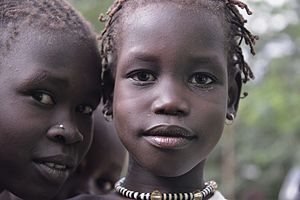Anyuak people
|
Anywaak children in Dimma, Ethiopia
|
|
| Total population | |
|---|---|
| (Approximately 1.5 million people) | |
| Regions with significant populations | |
| South Sudan, Ethiopia | |
| Languages | |
| Anuak | |
| Religion | |
| Christianity, Traditional | |
| Related ethnic groups | |
| Acholi, Shilluk, other Luo peoples, other Nilotic peoples |
The Anuak, also known as the Anyuak, Agnwak and Anywaa, are a Luo Nilotic ethnic group inhabiting parts of East Africa. The Anuak belong to the larger Luo family group. Their language is referred to as Dha-anywaa. They are primarily found in villages situated along the banks and rivers of southeastern South Sudan as well as southwestern Ethiopia, especially the Gambela Region. Group members number between 900,000 and 950,000 people worldwide.
The "Anuak" are from the family of Nilotes. They have lived in the area of the Upper Nile for hundreds of years and consider their land to be their tribal land. Hundreds of thousands of Anuak people immigrated to the United States to escape the wars, where they live mostly in Minnesota, which had a refugee resettlement program.
Unlike other Nilotic peoples in the Upper Nile, whose economies are based on raising cattle, the Anuak are herdsmen and farmers. They are believed to have a common origin with their northern neighbors, the Luo and Shilluk. Also, they share a similar language with their neighbors to the south, the Acholi.
The Luo peoples are scattered all over Eastern Africa, including Sudan and Ethiopia; they identify as a people who have preserved their cultural heritage wherever they reside. The Luo- speaking people of Eastern Africa are found beyond the Sudan and Ethiopia in Uganda, Kenya, Tanzania and the Congo. Their language(s) and dialects belong to the broader cluster of Nilo-Saharan languages.
The Gambela region is hot and tropical with rich, fertile, well-watered soil coming from the rivers. Much is carried down from the mountains of the highlands, which has a cooler, dryer climate. The differences in geography have caused self-identification by Ethiopians into distinctive categories of "lowlanders", such as the Anuak and other indigenous groups in the area, as opposed to the "highlanders." The latter, including the Amhara, Oromo, and Tigrayan ethnicities, comprise the majority of the population of Ethiopia.
...
Wikipedia

